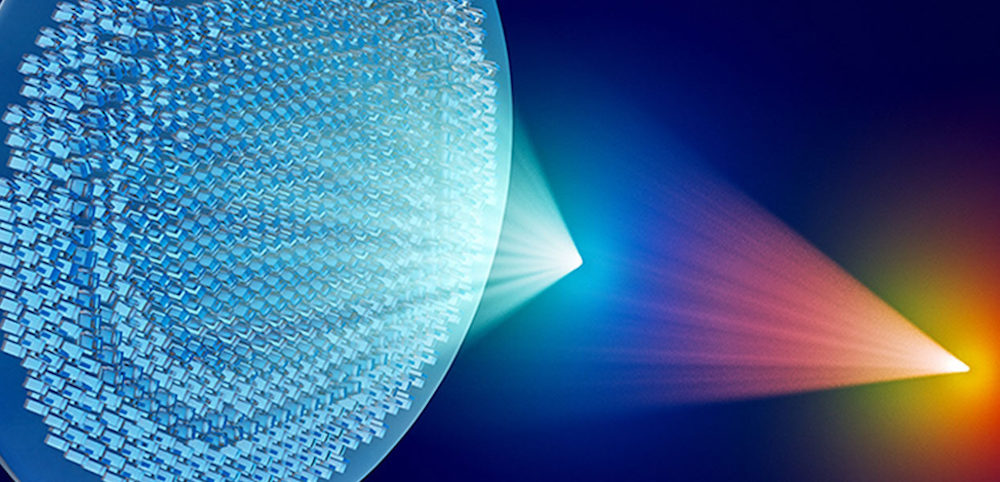
[Image above] Could infiltrating metalenses with liquid crystals allow dynamic control of the lenses’ optical properties? Credit: Case Western Reserve University
I am no camera aficionado, but one thing I do know is the more lenses a camera has, the more expensive it likely will be.
When light passes through a glass or plastic lens, it tends to become distorted. Correcting the distortion requires multiple curved lenses of varying thickness, so high-end cameras contain numerous lenses to achieve the best correction.
In recent years, a new technology that negates the need for multiple lenses began generating interest—metalenses.
Metalenses are a type of metasurface, meaning the surface is artificially nanostructured to impart the material with unique abilities. The surface of a metalens consists of nanoscale arrays of columns or fin-like structures, which allow the metalens to focus light without causing image distortion. As such, only a single metalens is required to focus light rather than multiple curved lenses, thus opening the doorway for miniaturization of optical devices and other electronics.
Researchers at the Harvard School of Engineering and Applied Sciences (SEAS) first demonstrated the potential of metalenses to work with high efficiency within the visible spectrum of light in 2016. Since then, researchers around the world have conducted many more studies to understand and improve this technology.
Companies and government agencies are beginning to take notice—metalenses were selected as among the Top 10 Emerging Technologies by the World Economic Forum in 2019. However, metalenses still face a few limitations compared to traditional lenses, including lower light transmission efficiency and size restraints.
Overcoming these limitations are key goals for metalens researchers. I covered one study last December that addressed the size restraint by creating metalenses using deep-ultraviolet projection lithography. And in today’s CTT, I feature a new study addressing another limitation—the lack of dynamic control over optical properties.
Metasurfaces are generally designed to fulfill a single functionality, meaning they cannot be reconfigured to serve other purposes.
“This presents a barrier to potential application where differing optical responses may be necessary,” researchers write in the new paper.
The researchers come from Case Western Reserve University, Harvard SEAS, and University of Calabria (Italy). They note numerous studies in recent years have explored different methods by which to design reconfigurable metasurfaces, such as mechanical and thermal approaches. And in their paper, they explore yet another approach—using liquid crystals to modify a metalens’ optical properties.
Liquid crystals are a birefringent complex fluid, meaning the fluid has two different refractive indices that correspond to the polarization of light.
Previous studies investigated creating reconfigurable optics using conventionally sandwiched liquid crystal cells with one of the two plates coated with a metasurface. However, “Opposed to these implementations involving a bulky [liquid crystal] cell, we propose in this work to harness the wetting properties of the metalens to replace the air between the planar nanostructures,” the researchers write.
“This implementation allows for controlling phase and amplitude distribution in the metalens plane, thereby limiting the optical changes that are unavoidable with thick [liquid crystal] slabs laying above the metasurface,” they add.
The researchers used three common thermotropic rod-shaped nematic liquid crystals—MBBA (Sigma-Aldrich), E7 (Merck), and BL009 (Beam Co.)—to modify the optical properties of metalenses composed of fused silica nanopillars on a fused silica substrate.
They found infiltrating the metalens with liquid crystals noticeably affected the optical properties. In particular, there was a loss in focusing ability following infiltration, the cause of which they explain in the paper.
“The metalens structures are designed for ambient conditions, … They are not designed to accommodate the relatively small index contrast produced by infiltration of [nematic liquid crystals] whose refractive indices are similar to the constituent material,” they write. “This reduction of the index contrast leads to a corresponding decrease in the metalens focusing ability observed here.”
The researchers note more studies are needed on controlling the local molecular orientation of liquid crystals and on designing metalenses to better accommodate infiltration. However, “This is just the first step, … and we have already been contacted by companies interested in this technology,” Giuseppe Strangi, senior author and physics professor at Case Western, says in the press release.
The paper, published in Proceedings of the National Academy of Sciences USA, is “Optical properties of metasurfaces infiltrated with liquid crystals” (DOI: 10.1073/pnas.2006336117).
